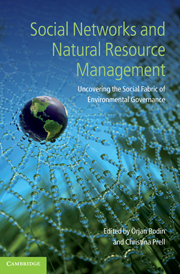 Social Networks and Natural Resource Management
Social Networks and Natural Resource Management Book contents
- Frontmatter
- Contents
- Contributors
- Foreword
- Part I Introduction
- Part II Case studies
- 4 Barriers and opportunities in transforming to sustainable governance: the role of key individuals
- 5 Social network analysis for stakeholder selection and the links to social learning and adaptive co-management
- 6 Who and how: engaging well-connected fishers in social networks to improve fisheries management and conservation
- 7 The effects of social network ties on the public’s satisfaction with forest management in British Columbia, Canada
- 8 Social network models for natural resource use and extraction
- 9 Friends or neighbors? Subgroup heterogeneity and the importance of bonding and bridging ties in natural resource governance
- 10 The role of individual attributes in the practice of information sharing among fishers from Loreto, BCS, Mexico
- 11 Transformative collective action: a network approach to transformative change in ecosystem-based management
- 12 Social networks, joint image building, and adaptability: the case of local fishery management
- 13 Agrarian communication networks: consequences for agroforestry
- Part III Summary and outlook
- Index
- References
5 - Social network analysis for stakeholder selection and the links to social learning and adaptive co-management
from Part II - Case studies
Published online by Cambridge University Press: 05 June 2012
- Frontmatter
- Contents
- Contributors
- Foreword
- Part I Introduction
- Part II Case studies
- 4 Barriers and opportunities in transforming to sustainable governance: the role of key individuals
- 5 Social network analysis for stakeholder selection and the links to social learning and adaptive co-management
- 6 Who and how: engaging well-connected fishers in social networks to improve fisheries management and conservation
- 7 The effects of social network ties on the public’s satisfaction with forest management in British Columbia, Canada
- 8 Social network models for natural resource use and extraction
- 9 Friends or neighbors? Subgroup heterogeneity and the importance of bonding and bridging ties in natural resource governance
- 10 The role of individual attributes in the practice of information sharing among fishers from Loreto, BCS, Mexico
- 11 Transformative collective action: a network approach to transformative change in ecosystem-based management
- 12 Social networks, joint image building, and adaptability: the case of local fishery management
- 13 Agrarian communication networks: consequences for agroforestry
- Part III Summary and outlook
- Index
- References
Summary
Introduction
There is now widespread recognition in the academic and wider community that those who are affected by, or who have the power to affect environmental decision-making processes, have a right to be consulted (e.g. the EU’s Aarhus Convention enshrines this right in law). There is also growing evidence that their involvement may enhance the quality of decisions made (Prell et al., 2008). However, these benefits depend upon appropriate representation of stakeholders, and this poses significant challenges. In many cases, the population of stakeholders is unknown, and thus, locating a representative sample is difficult. In addition, different stakeholders are likely to have different views about what are the relevant issues, and who are the most relevant parties to invite to the table. In this chapter, we put forward social network analysis as a complementary tool to help unravel who is a relevant stakeholder. In doing so, we argue that including a network analysis of stakeholders demonstrates another dimension to the idea of “diversity” in considering “wide representation” of stakeholders. In addition to trying to capture a diversity of perspectives from diverse stakeholder categories, we argue for considerations of diversity based on social networks, i.e. diverse positions within a wider network structure, and demonstrate how social network analysis can be used for uncovering such positions.
- Type
- Chapter
- Information
- Social Networks and Natural Resource ManagementUncovering the Social Fabric of Environmental Governance, pp. 95 - 118Publisher: Cambridge University PressPrint publication year: 2011
References
- 10
- Cited by


